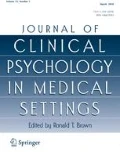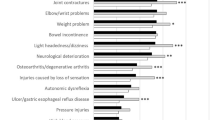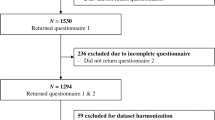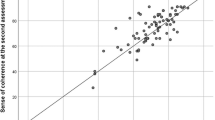Abstract
The current study employed a case-control design to examine the impact of marital status on adjustment among individuals with spinal cord injury (SCI) 1 year post-injury. Two groups of 53 individuals (i.e., single versus married individuals) were matched case-for-case on age (i.e., within 10 years), education, gender, race, and lesion level. Although not specifically matched, etiology of SCI, and number of rehospitalizations and days rehospitalized during the past year were not significantly different between groups. Outcome measures included the Satisfaction With Life Scale, the Craig Handicap Assessment and Reporting Technique (CHART), and the SF-12. Results indicated that overall self-reported QOL was significantly lower among single individuals as compared to their matched married counterparts. Similarly, self-reported handicap was significantly higher among single individuals, particularly in the areas of social integration and economic self-sufficiency. In contrast, overall physical and mental health were not different across groups.
Similar content being viewed by others
REFERENCES
Abrams, K. S. (1981). The impact on marriages of adult–onset paraplegia. Paraplegia, 19, 253–259.
Boekamp, J. R., Overholser, J. C., & Schubert, D. S. (1996). Depression following a spinal cord injury. International Journal of Psychiatry in Medicine, 26, 329–349.
Bolger, N., Foster, M., Vinokur, A. D., & Ng, R. (1996). Close relationships and adjustment to a life crisis: The case of breast cancer. Journal of Personality & Social Psychology, 70, 283–294.
Cassel, J. (1974). Social science in epidemiology: Psychosoical processes and stress theoretical formulation. International Journal of Health Services, 4, 537–549.
Chwalisz, K., & Vaux, A. (2000). Social Support and Adjustment to Disability. In R. G. Frank & T. R. Elliott (Eds.), Handbook of rehabiliation psychology. Washington, DC: American Psychological Association.
Cohen, J. (1977). Statistical power analysis for the behavioral sciences (Rev. ed.). New York: Academic Press.
Coyne, J. C., & DeLongis, A. (1986). Going beyond social support: The role of social relationships in adaptation. Journal of Consulting and Clinical Psychology, 54, 454–460.
Coyne, J. C., & Smith, D. A. (1991). Couples coping with a myocardial infarction: A contextual perspective on wives' distress. Journal of Personality & Social Psychology, 61, 404–412.
Cutrona, C. (1984). Social support and stress in the transition to parenthood. Journal of Abnormal Psychology, 51, 201–208.
Dakof, G. A., & Taylor, S. E. (1990). Victims' perceptions of social support:What is helpful from whom? Journal of Personality and Social Psychology, 58, 80–89.
Decker, S. D., & Schulz, R. (1985). Correlates of life satisfaction and depression in middle–aged and elderly spinal cord–injured persons. American Journal of Occupational Therapy, 39, 740–745.
DeVivo, M. J., & Fine, P. R. (1985). Spinal cord injury: Its shortterm impact on marital status. Archives of Physical Medicine and Rehabilitation, 66, 501–504.
DeVivo, M. J., Hawkins, L. N., Richards, J. S., & Go, B. K. (1995). Outcomes of post–spinal cord injury marriages. Archives of Physical Medicine and Rehabilitation, 76, 130–138.
Diener, E., Emmons, R., Larsen, R., & Griffin, S. (1985). The SatisfactionWith Life Scale. Journal of Personality Assessment, 49, 71–75.
Elliott, T. R., & Frank, R. G. (1996). Depression following spinal cord injury. Archives of Physical Medicine and Rehabilitation, 77, 816–823.
Elliott, T. R., Herrick, S. M., Patti, A. M., Witty, T. E., Godshall, F. J., & Spruell, M. (1991). Assertiveness, social support, and psychological adjustment following spinal cord injury. Behaviour Research & Therapy, 29, 485–493.
Elliott, T. R., Herrick, S. M., Witty, T. E., Godshall, F. J., & Spruell, M. (1992). Social support and depression following spinal cord injury. Rehabilitation Psychology, 37, 37–48.
Elliott, T. R., Marmarosh, C., & Pickelman, H. (1994). Negative affectivity, social support, and the prediction of depression and distress. Journal of Personality, 62, 299–319.
Elliott, T. R., & Shewchuk, R. M. (1995). Social support and leisure activities following severe physical disability: Testing the mediating effects of depression. Basic and Applied Social Psychology, 16, 471–487.
Fordyce, W. E. (1976). Behavorial methods in chronic pain and illness. St. Louis, MO: Mosby.
Fordyce, W. E. (1988). Pain and suffering. A reappraisal. American Psychologist, 43, 276–283.
Gandek, B., Ware, J. E., Aaronson, N. K., Apolone, G., Bjorner, J. B., Brazier, J. E., Bullinger, M., Kaasa, S., Leplege, A., Prieto, L., & Sullivan, M. (1998). Cross–validation of item selection and scoring for the SF–12 Health Survey in nine countries: results from the IQOLA Project. International Quality of Life Assessment. Journal of Clinical Epidemiology, 51, 1171–1178.
Go, B. K., DeVivo, M. J., & Richards, J. S. (1995). The epidemiology of spinal cord injury. In S. L. Stover, J. A. DeLisa, & G. G. Whiteneck (Eds.), Spinal cord injury: Clinical outcomes from the model systems (pp. 21–55). Gaithersburg, MD: Aspen Publishers.
Hall, K. M., Dijkers, M., Whiteneck, G.G., Brooks, C. A., & Krause, J. S. (1998). The Craig Handicap Assessment and Reporting Technique (CHART): Metric properties and scoring. Topics in Spinal Cord Injury Rehabilitation, 4, 16–30.
Hamilton, B. B., Granger, C. V., Sherwin, F. F., Zielezne, M., & Tashman, J. S. (1987). Auniform national data system for medical rehabilitation. In M. J. Fuhrer (Ed.), Rehabilitation outcomes: Analysis and measurement (pp. 137–147). Baltimore, MD: Brookes Publishing.
Hamilton, B. B., Laughlin, J. A., Fiedler, R. C., & Granger, C. V. (1994). Interrater reliability of the 7–level functional independence measure (FIM). Scandinavian Journal of Rehabilitation Medicine, 26, 115–119.
Hammell, K. R. (1994). Psychosocial outcome following spinal cord injury. Paraplegia, 32, 771–779.
Heinemann, A. W., Linacre, J. M., Wright, B. D., Hamilton, B. B., & Granger, C. (1993). Relationships between impairment and physical disability as measured by the Functional Independence Measure. Archives of Physical Medicine and Rehabilitation, 74, 566–573.
Holicky, R., & Charlifue, S. (1999). Ageing with spinal cord injury: The impact of spousal support. Disability & Rehabilitation, 21, 250–257.
Jenkinson, C., Layte, R., Jenkinson, D., Lawrence, K., Petersen, S., Paice, C., & Stradling, J. (1997). A shorter form health survey: Can the SF–12 replicate results from the SF–36 in longitudinal studies? Journal of Public Health Medicine, 19, 179–186.
Lane, C., & Hobfoll, S. E. (1992). How loss affects anger and alienates potential supporters. Journal of Consulting & Clinical Psychology, 60, 935–942.
Linacre, J. M., Heinemann, A.W., Wright, B. D., Granger, C. V., & Hamilton, B. B. (1994). The structure and stability of the Functional Independence Measure. Archives of Physical Medicine and Rehabilitation, 75, 127–132.
Lundberg, L., Johannesson, M., Isacson, D. G., & Borgquist, L. (1999). The relationship between health–state utilities and the SF–12 in a general population. Medical Decision Making, 19, 128–140.
Manne, S. L., & Zautra, A. J. (1989). Spouse criticism and support: their association with coping and psychological adjustment among women with rheumatoid arthritis. Journal of Personality & Social Psychology, 56, 608–617.
Pavot, W., & Diener, E. (1993). Review of the Satisfaction With Life Scale. Psychological Assessment, 5, 164–172.
Pavot, W., Diener, E., Colvin, C. R., & Sandvik, E. (1991). Further validation of the Satisfaction with Life Scale: Evidence for the cross–method convergence of well–being measures. Journal of Personality Assessment, 57, 149–161.
Pickard, A. S., Johnson, J. A., Penn, A., Lau, F., & Noseworthy, T. (1999). Replicability of SF–36 summary scores by the SF–12 in stroke patients. Stroke, 30, 1213–1217.
Rintala, D. H., Young, M. E., Hart, K. A., & Clearman, R. R. (1992). Social support and the well–being of persons with spinal cord injury living in the community. Rehabilitation Psychology, 37, 155–163.
Schulz, R., & Decker, S. D. (1985). Long–term adjustment to physical disability: The role of social support, perceived control, and self–blame. Journal of Personality and Social Psychology, 48, 1162–1172.
Schulz, R., Tompkins, C. A., Wood, D., & Decker, S. D. (1987). The social psychology of caregiving: Physical and psychological costs of providing support to the disabled. Journal of Applied Social Psychology, 17, 401–428.
Stambrook, M., MacBeath, S., Moore, A. D., Peters, L. C., Zubek, E., & Friesen, I. C. (1991). Social role functioning following spinal cord injury. Paraplegia, 29, 318–323.
Thompson, S. C., Bundek, N., & Sobolew–Shubin, A. (1990). The caregivers of stroke patients: An investigation of factors associated with depression. Journal of Applied Social Psychology, 20, 115–129.
Turk, D. C., Kerns, R. D., & Ronsenburg, R. (1992). Effects of marital interaction on chronic pain and disability: Examining the down side of social support. Rehabilitation Psychology, 37, 259–274.
Urey, J. R., & Henggeler, S.W. (1987). Marital adjustment following spinal cord injury. Archives of Physical Medicine and Rehabilitation, 68, 69–74.
Vaux, A. (2000). Social support: Theory, research, and intervention. New York: NY: Praeger.
Wan, G. J., Counte, M. A., & Cella, D. F. (1998). A framework for organizing health–related quality of life research. In E. A. Dobrzykowski (Ed.), Essential readings in rehabilitation outcomes measurement; Application, methodology, and technology (pp. 16–21). Gaithersburg, Maryland: Aspen Publishers, Inc.
Ware, J. E., Kosinski, M., & Keller, S.D. (1995). SF–12: Howto score the SF–12 physical and mental health summary scales (2nd ed.). Boston, Massachusetts: The Health Institute: New England Medical Center.
Whiteneck, G. G., Charlifue, S. W., Gerhart, K. A., Overholser, J. D., & Richardson, G. N. (1992). Quantifying handicap: a new measure of long–term rehabilitation outcomes. Archives of Physical Medicine and Rehabilitation, 73, 519–526.
Yim, S. Y., Lee, I. Y., Yoon, S. H., Song, M. S., Rah, E.W., & Moon, H. W. (1998). Quality of marital life in Korean spinal cord injured patients. Spinal Cord, 36, 826–831.
Author information
Authors and Affiliations
Rights and permissions
About this article
Cite this article
Putzke, J.D., Elliott, T.R. & Richards, J.S. Marital Status and Adjustment 1 Year Post-Spinal-Cord-Injury. Journal of Clinical Psychology in Medical Settings 8, 101–107 (2001). https://doi.org/10.1023/A:1009555910604
Issue Date:
DOI: https://doi.org/10.1023/A:1009555910604




